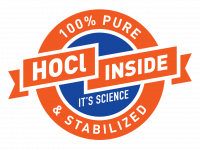Bacillus cereus
Story At-A-Glance
- Bacillus cereus (B. cereus) is a class of bacteria which is very robust and hard to kill
- When B. cereus endospores are exposed to favorable growing conditions, they can contaminate raw or processed food. They can also invade the body through damaged human skin. This contamination can become toxic. Once inside the body, Bacillus cereus can lead to mild food poisoning, or potentially very dangerous non-intestinal infections.
- HOCl is extremely effective when used to kill B. cereus
What is Bacillus cereus?
Bacillus cereus (B. cereus) is a class of bacteria which under adverse conditions can form spores.1 A spore is a “dormant, nonreproductive body formed by certain bacteria, often in response to a lack of nutrients, and characteristically being highly resistant to heat, desiccation, and destruction by chemicals or enzymes.”2 Characteristic of a spore is its ability to remain dormant for long periods in extreme environmental conditions and then reawaken when conditions turn favorable.3
B. cereus is part of a class of spores known as “endospores”. Endospores can withstand extremes in temperature from nearly absolute zero up to 150°C. They can also withstand various chemicals, ultraviolet radiation, drought, sterilization, pasteurization, antimicrobial treatments, and lack of nutrients.4,5 These endospores come back to life once the surrounding conditions favor bacterial growth.6
Favorable growing conditions for B. cereus endospores include any temperature between 8° and 55°C.7 This bacteria can be found in soil, on vegetables, and in many raw and processed foods.9 Particularly troubling for the food processing and agricultural sectors, B. cereus endospores are resistant to cleaning procedures, as they are quite good at sticking to processing equipment.8 Notwithstanding its prevalence in the food sector, this bacterium also impacts other sectors such as healthcare.10
The Problem
When B. cereus endospores are exposed to favorable growing conditions, they can contaminate raw or processed food or damaged human skin.11 This contamination can become toxic. If humans somehow engage this toxin, it can lead to mild food poisoning or potentially very dangerous non-intestinal infections.12
Effectiveness of HOCl
Research on HOCl has been ongoing for several decades. In 1973, a research team tested the efficacy of “electrolyzed oxidizing” (EO) water in killing the B. cereus bacterium under a variety of conditions. What they found was EO water killed 99.9% of the bacteria in all situations within 5 minutes.13 Furthermore, they determined HOCL was the agent within the EO which was responsible for the killing of the B. cereus.14 In 2000, a research team confirmed HOCL was the primary agent within “electrolyzed oxidizing” water which was responsible for killing B. cereus endospores.15 As B. cereus endospores are very difficult to kill, it is indeed encouraging HOCl has been shown to be effective at killing these hard-to-kill bacterium.
Sources and References
- 1, 9 U.S. FDA, BAM Chapter 14: Bacillus cereus, Sandra M. Tallent, Ann Knolhoff, E. Jeffery Rhodehamel (ret.), Stanley M. Harmon (ret.), and Reginald W. Bennett (ret.)
- 2, 3 The American Heritage® Medical Dictionary
- 4, 6 NCBI: Bacterial Spores, Marina Basta; Pavan Annamaraju
- 5 Epedia: Difference Between Spore Forming Bacteria and Non Spore Forming Bacteria
- 7, 8 ScienceDirect, Encyclopedia of Toxicology (Third Edition): Bacillus cereus, H.S.Parihar
- 10 ScienceDirect, The Diverse Faces of Bacillus cereus, Giovanni Gherardi, 2016
- 11 ScienceDirect: Infectious Diseases, Guy Prod’hom, Jacques Bille, (Third Edition), 2010
- 12 ScienceDirect: Microbiology of Bacillus cereus, Roberta Marrrollo, 2016
- 13, 14 Destruction of Psychrophilic Strains of Bacillus by Chlorine, Mary Yu Wang, E. B. Collins, and J.C. Lobben, Department of Food Science and Technology, University of California, Davis, 1973
- 15 Journal of Food Protection 63.11 (2000): Ultraviolet spectrophotometric characterization and bactericidal properties of electrolyzed oxidizing water as influenced by amperage and pH, Soo-Voon Len, Yen-Con Hung, Marilyn Erickson, and Chyer Kim
